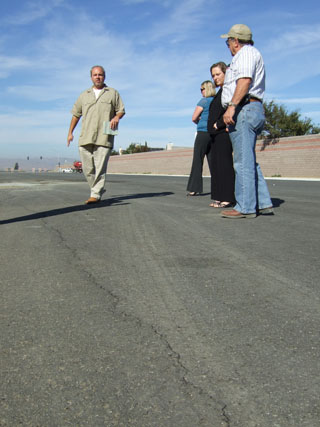
Cracks appearing on new 25 force delay
All the people looking forward to the opening of the Highway 25
bypass around downtown Hollister will have to wait a little bit
longer.
A series of cracks appeared recently along the edges of the
roadbed in several sections, and repairing them will require
several weeks’ work.
Cracks appearing on new 25 force delay
All the people looking forward to the opening of the Highway 25 bypass around downtown Hollister will have to wait a little bit longer.
A series of cracks appeared recently along the edges of the roadbed in several sections, and repairing them will require several weeks’ work.
Until recently the bypass was on track to be opened before the Nov. 24 contract deadline, but the appearance of the stitchwork of narrow cracks running parallel to the roadway means that motorists probably won’t get the green light to travel the long-anticipated route until the end of the year – if the weather cooperates.
A wet, cold winter could mean the project might be stalled until next spring.
Conditions need to be dry, and temperatures must remain above 50 degrees to lay asphalt and to stripe lanes, according to Kerry Theran, the engineer in charge of overseeing the $23 million, three-mile expressway.
The problem, Theran explained during a tour last week, lies with the Hollister area’s notoriously clay-rich soils. Anyone who has observed the mosaic of cracks in a pond or swale knows that clay soils expand and contract depending on the amount of moisture they hold.
To counteract that tendency, the construction contract for the bypass mandated that the top 20 inches of the entire area under the roadbed be treated with lime, a mineral powder that counteracts clay’s tendency to squirm when wet.
“The lime basically changes the chemical compounds in clay so it’s not really clay any more,” Theran said. “The clay underneath the lime can still expand and contract, but it will not go through the lime.”
Theran’s firm, Quincy Engineering of Sacramento, only supervises the project and performs quality assurance. The actual bypass work is being done by the Pavex Construction Division of Graniterock.
“There is no indication that the contractor [Pavex] skimped or did not place lime,” Theran said. The problem, he explained, is related to the equipment used to blend lime into the soil. Theran likened the machinery to a giant rototiller, and just like a backyard tiller, the machine cannot reach to the edge of a roadbed that’s confined by dirt berms.
Plans called for workers to groom the edges of the roadbed with smaller machinery, but core samples reveal that the work was inconsistent, Theran said.
While the cracks are not a particular problem today, they could open up the roadbed to rainfall and, ultimately, erosion, said Lisa Rheinheimer of the county Council of Governments, the agency overseeing the project.
Rheinheimer explained that under the terms of COG’s contract with Pavex, the firm will be fined $8,600 for every day the project runs after Nov. 24, including weekends.









